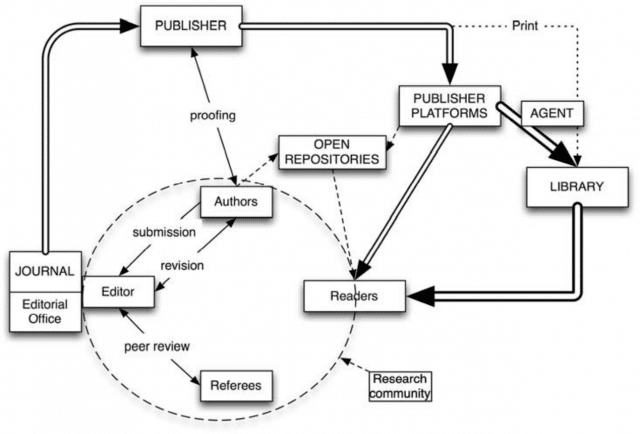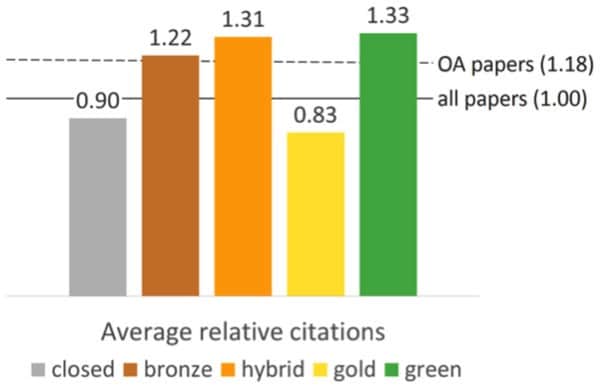
The missing link in the academic publishing cycle
The process of discovery and access to academic content is not part of the publishing cycle which blurs the lines of responsibility between the publishers, the libraries and the researchers. This results in frustrated researchers and libraries, and publishers providing a sub-optimal experience to the users of their platforms.
The academic publishing cycle
The publishing cycle is defined by STM as “the movement of information between the different participants in the journal publishing process.” (STM Report, 2018)
“Research, created by an author from a particular research community, passes through the journal editorial office of the author’s chosen journal to its journal publisher, subscribing institutional libraries before ending up back in the hands of the readers of that research community as a published paper in a journal.” (STM Report, 2018)
The publishing cycle doesn’t capture much about the research process beyond the peer review. However, being able to find and access quality research is fundamental to any academic paper.
The researcher experience
Both researchers and learners use a range of discovery methods when researching their topic of interest. Often their ability to access content depends on a number of factors:
Are they affiliated with a library?
Knowing if one is affiliated with a library is straightforward when they are a student or a researcher. Online access to library content is less obvious for public library patrons.
A research starting point for library members is often the online library portal. Lack of library membership means that researchers have to pay to access content (STM Report, 2018).
Does the library subscribe to the journal or database?
In some cases, library affiliation is not sufficient as shrinking library budgets and the high price of journal subscriptions mean that certain resources may not be available through the library portal.
Google and Google Scholar are also popular research discovery tools with users using the full range of content discoverable by the search engine. Scholarly articles or not, images, videos, infographics are all used to speed up the research.
Searching and trying to access research outside the library online portal, makes it challenging for the user to know if their library subscribes to the content or not. The STM report from 2018 quotes the lack of awareness of available resources among the most common barriers to access.
Are researchers working in the library, the university campus or off-site?
On-site access to content often does not require log-in because of the popular use of IP address as a primary authentication method.
On-site discovery and access to content often do not require authentication.
When off-campus, access to research becomes problematic because of technical limitations on the publishers’ platform using IP as their primary authentication method. That requires the use of Proxy asking the user to click on a specific link to gain access. This significantly limits the researchers’ discovery options placing the burden of the poor experience on the user.
Off-site discovery and access where publisher’s platforms using Proxy can not be accessed.
The Research for the 21st-century team (RA21) reports on scholars’ increasing frustration with obtaining access to institutionally-provided information resources as they expect access from any location, at any time, and from any device. (NISO RP-27–2019)
The log-in effect
Here at OpenAthens, we conduct our own research on the user journey to content and we understand the importance of easy and seamless log-in experience to minimizes the friction in the user journey to academic content.
A recent study by Piwowar, H. et al (2018) demonstrates the positive effect on the number of citations per paper when log-in is not required.
“Papers hidden behind a paywall were cited 10% below world average (ARC = 0.90), while those that are freely available obtain, on average, 18% more citations than what is expected.” (Piwowar, H. et al, 2018)
Average relative citations of different access types of a random sample of WoS articles and reviews with a DOI published between 2009 and 2015. DOI: 10.7717/peerj.4375/fig-5
Why access is not part of the publishing cycle?
Failing to recognize that researchers need to be able to find and access academic content to produce papers as part of the publishing cycle, makes it clear that this is not an immediate priority for the publishing community.
Discoverability and accessibility traditionally are a library domain of expertise but in a digital world, libraries can not moderate the user experience in the same way as they can with the physical library space. Libraries pay the subscription bill and they are heavily dependent on the publishers to recognize and deliver to the researchers and learners needs.
Aligning priorities
The different measures of success along the publishing cycle are symptomatic of the different priorities for the stakeholders involved. Is the number of papers, or the number of citations or the number of views and downloads that matters?
By measuring the number of subscribers, however, publishers conveniently brush the problem with discovery and access under the carpet. With a weak link between the number of subscribers and their ability to access the content, the problem remains low on the publishers’ priority list.
Owning the problem
RA21 and NISO have published the Recommended Practices for Improved Access to Institutionally-Provided Information Resources, which calls for a common approach to access across publishers, libraries and researchers.
The RA21 recommendations are founded on the following guiding principles:
- The user experience for researchers will be as seamless as possible, intuitive and consistent across varied systems, and meet evolving user expectations.
- The solution will work effectively regardless of the researcher’s starting point, physical location, or preferred device.
- The solution will be consistent with emerging privacy regulations, will avoid requiring researchers to create yet another ID, and will achieve an optimal balance between security and usability.
- The system will achieve end-to-end traceability, providing a robust, widely adopted mechanism for detecting fraud that occurs at institutions, vendor systems, and publishing platforms.
- The Institution will not be burdened with administrative work or expenses related to implementation and maintenance. The implementation plan should allow for gradual transition and account for different levels of technical and organizational maturity in participating institutions. (NISO RP-27–2019)
There is no question that implementing the RA21 recommendation requires investment in improved publisher platforms. However, without a clear increase in demand from the library community publishers will continue to struggle to formulate a compelling business case for improved user experience. Until then access remains the missing link in the academic publishing cycle.




